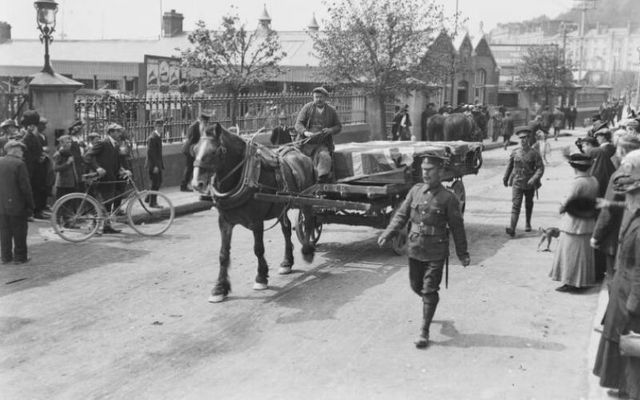Sixty striking images, mostly taken in Cobh in the aftermath of the Lusitania tragedy, were made public for the 100th anniversary of the tragedy, in 2015.
The A.H. Poole Lusitania collection was digitized from glass plates held in the National Library of Ireland. The images had never been seen collectively in the 100 years since the photographs were taken.
The RMS Lusitania was sunk by a German U-boat off the coast of Cork on May 7, 1915, during World War I. The passenger ship was en route to Liverpool from New York when it sank killing 1,201 people.
The historic images can be viewed here or by appointment at the National Library of Ireland.
They capture in stunning detail survivors on the streets of Queenstown (Cobh), the mass funeral, and the burials in the Old Church Cemetery. It also contains a reproduction of the burial register of the Old Church Cemetery, photographs of the rescue vessels and their captains, and some present-day photographs showing how little the Cobh streetscape has changed.
Significantly, the photos were exhibited in 2015 in the Cunard Centre right in the heart of Cobh. This was the Cunard Line Ticket Office in 1915 and a portion of the building was used as a temporary morgue where some of the recovered bodies were laid out.
Colman Rasmussen, chairman of Cobh Credit Union said, "On seeing the photographs we immediately realized the story that they tell. The sinking of the Lusitania was a terrible tragedy with a local, national, and international dimension. It seemed appropriate that as the largest community-based business organization in Cobh that we would provide funding to allow them to be showcased right here in the town in which they were taken.”
It was Christy Keating, the genealogist at Cobh, The Queenstown Story Heritage Centre that at the end of 2014 went looking in the National Library of Ireland for images relating to the Lusitania tragedy.
Keating said, "I was brought into a room and shown this astounding collection of photographs on glass plates. I had seen some before but knew immediately that there were photographs here that have only been seen by a handful of people in over 100 years.
Very quickly the committee requested that the glass plates be digitized and that they could be exhibited in Cobh and the National Library duly obliged.
About half of the photographs are of survivors on the streets of Cobh following the sinking and most of these people are unnamed. Fionnghuala Smith, a renowned photographer, whose Old Time Photography Studio is also based in the Cunard Centre, commented on the apparent giddiness of many of the survivors.
"It's when you think about it that you realize that this can be a very natural reaction to being in a near-death experience," she says.
"There are very many relatives of survivors coming to Cobh on the 7th and 10th of May and I fully expect people to walk through our doors and point out their ancestors. It will be emotional, to say the least!"
On May 10, 1915, the mass funeral of over 145 victims of the tragedy took place in the Old Church Cemetery in Cobh. The funeral was impressive, dismal, ghastly, and exceedingly sad. The photographs of the funeral cortege and at the gravesides are a visual testimony to this. Thousands turned out to pay their final respects to the victims and there isn't a smile to be seen in a seemingly endless sea of faces. Respect is evident everywhere.
Displaying these photographs reveals the scale and horror of the sinking of the Lusitania.
* Originally published in 2015. Updated in 2024.




Comments